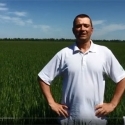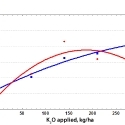30 Apr 2014
First results of research project on the improvement of K fertilizer recommendations in intensive cropping systems in Russia
S.E. Ivanova, V.A. Romanenkov, L.V. Nikitina
The continuous removal of potassium by crop and the incomplete return of the element with fertilisers lead to a slow but permanent decrease in the content of plant-available potassium in arable soils; its mobility in soil decreases, as well as the capacity of soil to restore the initial content of plant available potassium. The final result is a loss of yield and decreased crop quality.
The level of K fertilizer use is an indicator of intensity in crop production. Unfortunately, potash fertiliser application rates in Russia have decreased in the last 10–15 years to 1-2 kg K2O per hectare of cropped area; with long-term removal of K exceeding K inputs the negative K budgets are being observed in various agricultural zones of the country from –16 to –30 kg K2O/ha (Shafran, Sychev, 2013). Currently in Russia, potash is mainly applied as part of compound fertilisers, which do not always ensure a balanced potassium supply for plants.
Moreover, the negative K balance might lead to increased soil fixing capacity, and the low rates of potassium applied as part of compound fertilisers then have almost no effect on crop yields.
It is well-known that regular potash application in agro-ecosystems is necessary for them to function effectively. Nonetheless, the issue of optimizing of the potassium status of arable soils in Russia still receives insufficient attention. This attitude is largely related to the imperfect diagnostics of arable soil fertility in terms of potassium supply, which to a large extent depends on the routine method used to measure the content of plant available K in soil. It is preferable to use a combination of different methods, which will allow more accurate predictions of crop response to potash fertilisers and determining scientifically-based application rates.Therefore, the optimisation of potash application rates and verification of currently used routine soil K test methods are priority issues for the research project jointly organised by the International Plant Nutrition Institute (IPNI) and the D. Pryanishnikov All-Russian Research Institute of Agrochemistry, which started in autumn 2012.
The project is focused on optimisation of potash fertiliser rates in current intensive cropping systems for crops with high demand to K (sugar beet, corn, rape and soybean), as well as checking the measurement potential of routine soil test methods depending on the regional soil properties and adjusting the current soil K test interpretation classes based on the results obtained from short-term field experiments executed on large industrial farms. The complex approach has been used for the project design included the following issues:
• Determining crop response to potash fertilisers and their effect on crop quality and yield in high-yield crop systems;
• Determing the residual effect of potash applied to the crop with highest demand in potash;
• Evaluating the validity of routinely-used soil K test methods, and corresponding interpretation classes ;
• Assessing of crop removal and nutrient balance in trials;
• Assessing potash fertiliser economic efficiency.
The methodological basis of the research is three-year field experiments with increasing K rates applied to crops with high demand in K such as sugar beet, grain corn, soybean and rapeseed, which are grown intensively on large industrial farm in the Central Russia and North Caucasian regions.
Experiments are being carried out in the Lipetsk, Voronezh, Belgorod, and Rostov regions by the regional centres of the Russian State Agrochemical Service. The soil types being investigated are leached chernozem (Voronezh region), typical chernozem (Belgorod and Voronezh regions), podzolized chernozem (Lipetsk region), calcareous ordinary chernozem (Rostov region) and dark grey forest soil (Lipetsk region).
All industrial farms that participated in the project have much higher yields than the regional average. For example, all farms chosen for the sugar beet trials have average root yields above 55 t/ha. It is important to highlight that there are currently no potash fertiliser recommendations in Russia for obtaining such high yields. Therefore, the aim of the project is to be a unique source of information targeted first and foremost at agricultural producers, enabling them to obtain high yields.
The project’s first year results are very promising for all crops studied. However, this article only covers data obtained from sugar beet and grain corn trials in Central Russia after the first growing season (2012–13).
Sugar beet. Experimental plots in Lipetsk and Voronezh regions have been launched on chernozem soils with “increased” (higher than medium) content of plant available potassium routinely extracted by Chirikov method (0.5М CH3COOH).
The treatments included:
Absolute control (without fertilisers);Background treatment — nitrogen and phosphate treatment with optimal rates to planned high yield according to the each farm practice (NP);
NP+ K70 (NPK1);
NP+ K140 (NPK2);
NP + K210 (NPK3);
NP + K280 (NPK4).
Potash fertilisers have been applied in the form of potassium chloride (KCl). The rates of K fertilisers to be applied were calculated taking into account the possible residual effect on the two subsequent crops. Each trial utilised crop management technology.
In the sugar beet trials the aim was to obtain a high sugar beet root yield with an acceptable sucrose concentration in the roots (not less than 14%).
In the experiment conducted in the Voronezh region, the application of K fertilisers led to very high yields (more than 80 t/ha) combined with an acceptable concentration of sucrose in the roots (more than 14%).The highest yield of sugar beet roots and sucrose was achieved when applying 140 kg K2O/ha (NPK2). Yields therefore increased by 21% or 14 t/ha due to the application of potash compared to the background treatment. Moreover, potash fertilisers increased not only root yields but the sucrose concentration in roots as well. As a result, the sucrose yield increased by 2.5 t/ha, equivalent to 25% (Table.1, Fig. 1). The same rate provided the best economic efficiency of K application.
An evaluation of economic efficiency of potassium fertiliser application showed that for the treatment (NPK2) with the highest achieved yield (80 t/ha) the maximum increase in profitability due to K was 23%, which resulted in a net profit increase due to K of 22,000 roubles per ha and a decrease in production cost by 130 roubles per tonne of root yield (Table 2).
In the Lipetsk region, the sugar beet root yield was slightly lower than in the Voronezh region at approximately 57 t/ha. However, yield increase due to the application of different K rates was observed in all treatment categories. The maximum root yield was achieved by applying 280 kg K2O/ha (NPK4). At this rate, the root yield increase was 12.4 t/ha or 22% higher than in the background treatment. The sucrose yield increased by 2.5 t/ha, equivalent to a more substantial yield increase of 28%. The same rate provided the best economic efficiency.
An evaluation of economic efficiency of potassium fertilisers application showed that for the NPK4 treatment with the highest achieved yield (57 t/ha) the increase in profitability due to K was 23%, which resulted in a net profit increase of 12,000 roubles/ha and a decrease in production cost by 142 roubles/t root yield (Table 2).
As part of the sugar beet experiment in the Voronezh region, the dynamics of sugar accumulation in the roots were studied during the vegetation period until harvesting in autumn 2013. This period was characterised by intensive rainfall (for the majority of September) which resulted in delays to sugar beet harvesting. Sucrose concentration in the roots was measured starting from 7 August 2013. Analysis of the sugar accumulation dynamics (Table 3) showed that the sucrose concentration in roots in treatments with potassium chloride (KCI) increased by 0.2–0.9% at the end of August compared to the background treatment and then decreased substantially by 1.9–2.9%. Sucrose concentration in the roots was still above the acceptable level of 14% (Table 3).This decrease in sugar content in September was a result of the intense growth of the sugar beet plants during the period of abundant rainfall.
The highest values were observed on 27 August for the K280 treatment. The growth of sugar beet plants led to a reduction in the difference in sugar accumulation between the treatments, which explains the maximum sucrose concentration being achieved with the K140 treatment at harvesting (beginning of October).
These results demonstrate that it is possible to increase sugar concentration in the roots to more than 16% by applying potash fertilisers at the same time as achieving high yields. Therefore, both weather conditions and the harvesting timing are important factors that influence the accumulation of sugar in the roots and sucrose yield. This must be taken into account for crop management planning.
Grain corn. In the grain corn experiment, the following treatments were used:
Absolute control (without fertilisers);
Background treatment –NP at optimal levels to achievehigh yields;
Background +4 increasing K rates (K60–K280).
Potash fertilizers have been applied as potassium chloride. The rates of K fertilisers were calculated taking into account the possible residual effect on the two subsequent crops.
In the field experiment in the Voronezh region, the maximum grain yield was achieved at K120, a yield increase of 1.4 t/ha, or 14% compared to the background treatment alone (Table 4). Therefore, every 1 kg K2O resulted additional12 kg of grain. The same level of application provided the best economic efficiency. The net profit increase amounted to 7,974 rubles per hectare, profitability increased by 27% and production costs decreased by 70 rubles per tonne of grain (Table 2).
In the field experiment on grain corn in the Belgorod region, the maximum grain yield (9.4 t/ ha) was achieved at a K2O rate 280 kg/ha. In this treatment, yields increased by 1.9 t/ha, or 25% compared to the background treatment alone (Table 5).
Potash application led to an additional 7 kg of grain production per 1 kg of K2O. The same level of application provided the best economic efficiency. The net profit increase amounted to 3,300 roubles per hectare, profitability increased by 10% and production costs decreased by 100 rubles per tonne of grain (Table 2).
Based on the project’s first-year results with regard to sugar beet and grain corn, one can conclude that the substantial yield increases at all levels of potash fertiliser application in comparison to the background treatment show that there can be significant yield losses when potash fertiliser is not applied, even on soils with increased and high content of plant available K.
Literature
V.G.Sychev, S.A. Shafran. Agrochemical soil properties and the efficiency of mineral fertilisers. M. VNIIA, 2013. Pg. 96 (In Russian).




